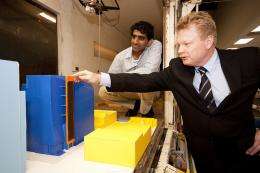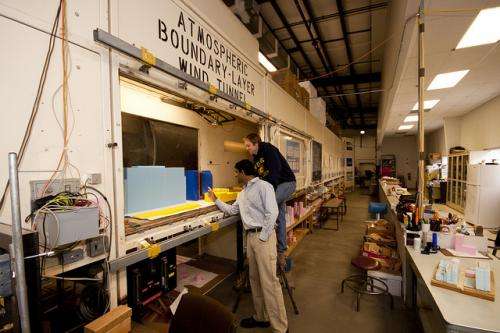Wind experts advise on revolutionary wind-powered skyscraper

The infamous winds that gust through downtown San Francisco streets, overturning kiosks and sometimes toppling pedestrians, will help to power a revolutionary skyscraper set to open next fall -- and could pave the way for a new world market for energy-generating wind turbines in new buildings.
The building, headquarters for the San Francisco Public Utilities Commission, will use a design developed with the help of UC Davis engineering professors. Incorporating an external vertical "wing" of wind turbines that stretch up to the roof, the design will produce at least 7 percent of the building's energy needs.
It was developed with the help of Bruce White, professor of mechanical and aerospace engineering and former dean of the UC Davis College of Engineering, and Case Van Dam, professor and chair of the Department of Mechanical and Aerospace Engineering, co-leaders of the UC Davis Wind Energy Collaborative.
The collaborative is one of six campus centers on renewable energy administered by the UC Davis Energy Institute, all focused on leading the way to a sustainable energy future.
For his part, White knows the winds of San Francisco better than those in his own back yard.
"Over the years, my UC Davis group and I have done a lot of consulting and advising on the winds in San Francisco," said White.
One of the projects, a wind analysis for the site of AT&T Park, home of the San Francisco Giants, may well have helped Barry Bonds to earn some of his home runs.
Indeed, when the UC Davis Wind Energy Collaborative, was first contacted about the new PUC building, White and his colleagues had already conducted ground-level studies of winds in downtown San Francisco, studies that determined that it would be economically feasible to install wind energy devices on high-rise buildings in the city.
Especially at 525 Golden Gate Ave, near the intersection of 10th and Market streets, the site of the new PUC headquarters.
"Tenth and Market is known to be one of the windiest areas in San Francisco," White said. "It's anecdotally famous for high winds and kiosks rolling down Market Street, and for people being blown over. Three nearby high-rises — Fox Plaza, the Bank of American Data Center and the California State Automobile Association — funnel the wind through and re-direct it down to the 10th and Market intersection. When the wind is coming in the right direction, it's really something."

The San Francisco PUC had previously obtained a wind analysis from RWDI, a consulting firm based in Ontario, Canada. But Masoud Vafaei, an engineer with the utilities commission and a graduate of UC Davis, persuaded the PUC to seek a second opinion.
"At the time of that earlier analysis, the San Francisco PUC hadn't nailed down the building's shape or additional features, so they also contacted Case for advice on what sort of wind energy device to use,” White said.
UC Davis graduate student Ashishkumar Patel built a model to test in the College of Engineering’s wind tunnel.
"San Francisco, in terms of being an environmentally conscious city, always has been a leader," White says. "This project will reinforce that image. The commission wanted to demonstrate that this is feasible; they want to show the way."
But while 10th and Market is a particularly attractive location for a wind-power project, high ground-level winds are not essential.
"In terms of applications for wind energy and renewables, every city is a potential candidate," White said. "As you go up, the wind increases. Once you're 200 feet or above, you get strong winds everywhere on Earth. Typically, the wind environment in urban settings isn't of the higher quality required for wind farms. But the offsetting component is that you cut out the middle person: You generate power on the building, and utilize the power in the building. You don't need to go to a power utility. You can be one-third as efficient as a wind farm, and still be economically feasible."
Perhaps the most controversial aspect of wind energy facilities concerns the incidence — and dangers — of bird strikes. San Francisco has taken this into account. The orientation of the turbines on 525 Golden Gate should minimize the problem, White said.
"The vertical axis design does not affect avian life, because it's like part of a building, and birds don't fly into buildings," White said. "Horizontal-axis turbines potentially would have generated better wind energy, but, politically, the vertical ones are more acceptable from both the safety viewpoint and the avian viewpoint. There should be very few bird kills, if any at all."
White is optimistic that wind turbines can be integrated into new buildings in an aesthetically pleasing way, improving energy efficiency, and realizing great commercial potential.
"While it's true that San Francisco's pedestrian-level ground winds are higher than in most cities — Chicago also has this feature — all cities have the ability to use wind-energy devices on high-rises. A tremendous world market could be developed."
Provided by UC Davis

















